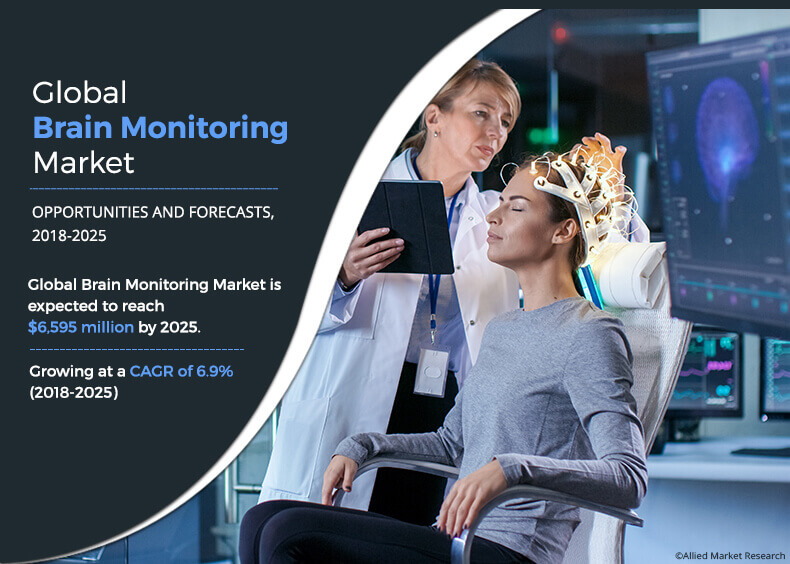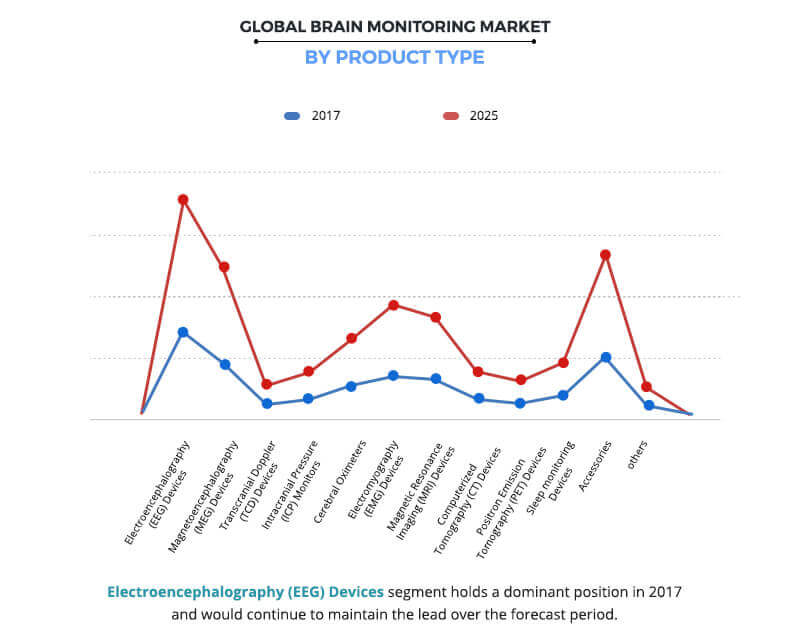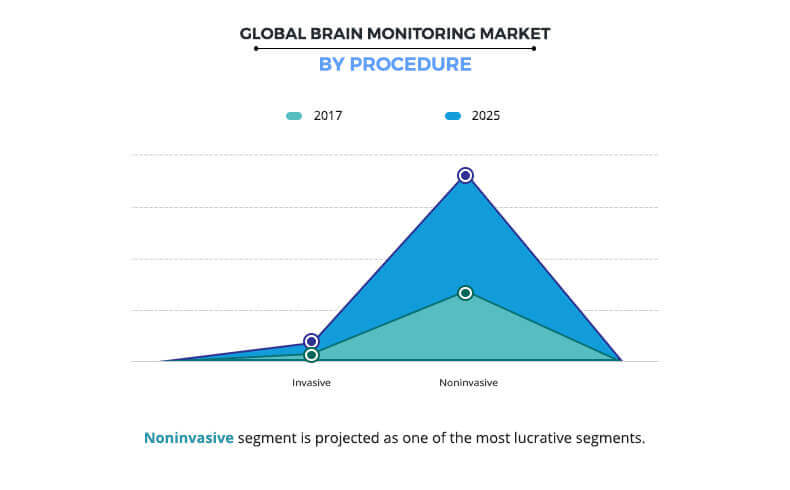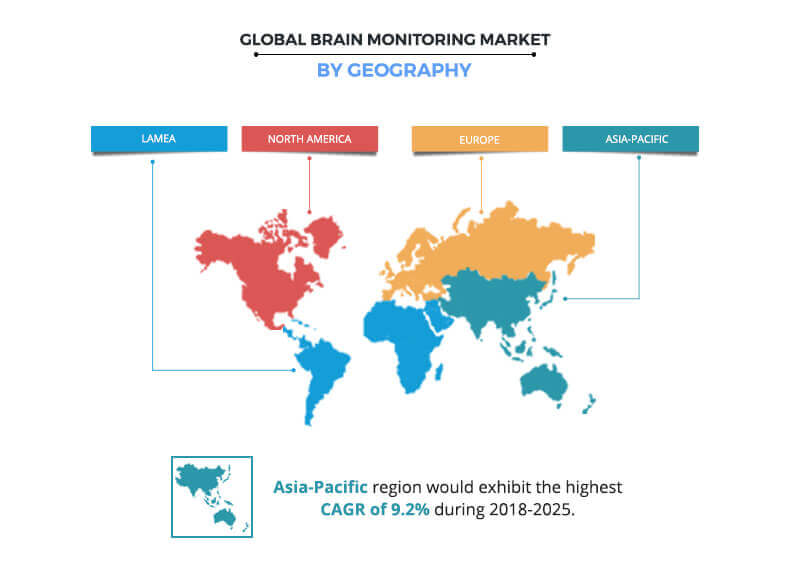Brain Monitoring Market Overview:
Brain monitoring devices are used to monitor and diagnose neurological conditions by exploring the structure and function of the brain. This process involves the use of several brain monitoring devices such as electroencephalography devices, intracranial pressure monitors, and magnetoencephalography to track brain functions. In addition, these devices help monitor neural and electrical activity in the brain. At present, there is an increase in the demand for electroencephalography devices among healthcare providers. The global brain monitoring market generated $3,850 million in 2017, and is projected to reach $6,595 million by 2025, growing at a CAGR of 6.9% from 2018 to 2025.
The global brain monitoring market is expected to register substantial growth in the near future, owing to the increase in the geriatric population and rise in prevalence of neurological disorders. In addition, technological advancements are expected to boost the market growth during the forecast period. However, stringent government regulations and unfavorable reimbursement policies are expected to hamper the market growth during the forecast period. Conversely, untapped markets in the developing countries is expected to offer remunerative opportunities for market players. The impact of the driving factors is expected to surpass that of the restraints.
Product Type segment review
Based on product type, the market is segmented into electroencephalography (EEG) devices, magnetoencephalography (MEG) devices, transcranial Doppler (TCD) devices, intracranial pressure (ICP) monitors, cerebral oximeters, magnetic resonance imaging (MRI) devices, computerized tomography (CT) devices, positron emission tomography (PET) devices, sleep monitoring devices, electromyography (EMG) devices, and accessories. The accessories segment is further classified into electrodes, sensors, pastes & gels, caps, cables, batteries, and others.
The EEG segment was the major revenue contributor in 2017 and is anticipated to remain dominant during the forecast period, owing to the increase in demand for advanced imaging techniques and rise in investments by device manufacturers. Furthermore, surge in demand for diagnosis of critical disorders such as epilepsy has further influenced companies to focus on the development of brain monitoring EEG devices.
Procedure segment review
Depending on procedure, the market is categorized into invasive and non-invasive. The non-invasive segment is projected to show fastest growth during the forecast period, due to rise in incidences of traumatic brain injuries, high acceptance rate of minimally invasive devices, and low risk of mortality. This increases the demand for these products that propels the market growth.
Region segment review
Based on region, the brain monitoring market is analyzed across North America, Europe, Asia-Pacific, and LAMEA. Asia-Pacific is expected to grow at the highest CAGR during the study period, as it offers lucrative opportunities for the market players, due to increase in number of geriatric population and people suffering from chronic diseases and rise in purchasing power of countries in the region.
The report provides a comprehensive analysis of the key players operating in the global brain monitoring market. These players include Advanced Brain Monitoring, Inc., CAS Medical Systems, Inc., Compumedics Ltd., General Electric Company (GE Healthcare), Koninklijke Philips N.V. (Philips Healthcare), Medtronic Plc., Natus Medical Incorporated, Neural Analytics, Inc., and Siemens AG.
The other players include Cadwell Laboratories, Neurosoft Limited, Elekta A.B., InfraSacn, Inc., and BrainScope Company, Inc., and others.
Key Benefits for Brain Monitoring Market:
- This report provides a detailed quantitative analysis of the current market trends and future estimations from 2018 to 2025, which assists to identify the prevailing market opportunities.
- An in-depth analysis of various regions is anticipated to provide a detailed understanding of the current trends to enable stakeholders formulate region-specific plans.
- A comprehensive analysis of the factors that drive and restrain the growth of the global brain monitoring market is provided.
- An extensive analysis of various regions provides insights that are expected to allow companies to strategically plan their business moves.
Brain Monitoring Key Market Segments:
Product Type
- Electroencephalography (EEG) Devices
- Magnetoencephalography (MEG) Devices
- Transcranial Doppler (TCD) Devices
- Intracranial Pressure (ICP) Monitors
- Cerebral Oximeters
- Magnetic Resonance Imaging (MRI) Devices
- Computerized Tomography (CT) Devices
- Positron Emission Tomography (PET) Devices
- Sleep Monitoring Devices
- Electromyography (EMG) Devices
- Accessories
- Electrodes
- Sensors
- Pastes and Gels
- Caps
- Cables
- Batteries
- Others
By Procedure
- Invasive
- Non-invasive
By Application
- Epilepsy
- Dementia
- Parkinson's Disease
- Huntington's Disease
- Headache Disorders
- Stroke
- Traumatic Brain Injuries
- Sleep Disorders
- Other Diseases
By Region
- North America
- U.S.
- Canada
- Mexico
- Europe
- Germany
- France
- Spain
- Italy
- UK
- Rest of Europe
- Asia-Pacific
- Australia
- Japan
- India
- China
- Rest of Asia-Pacific
- LAMEA
- Brazil
- Saudi Arabia
- South Africa
- Rest of LAMEA
Brain Monitoring Market Report Highlights
| Aspects | Details |
| By PRODUCT TYPE |
|
| By PROCEDURE |
|
| By APPLICATION |
|
| By Region |
|
| Key Market Players | KONINKLIJKE PHILIPS N.V. (PHILIPS HEALTHCARE), SIEMENS AG, MEDTRONIC PLC., NEURAL ANALYTICS, INC., CAS MEDICAL SYSTEMS, INC., NIHON KOHDEN CORPORATION, GENERAL ELECTRIC COMPANY (GE HEALTHCARE), COMPUMEDICS LTD., NATUS MEDICAL INCORPORATED, ADVANCED BRAIN MONITORING, INC. |
Analyst Review
The abnormality in brain functions including blood flow, magnetic movement, cerebral oxygen capacity, electrical motion, and others can lead to severe symptoms such as paralysis, tremors, loss of sensation, and muscle pain & weakness. The diseases associated with the brain are very complicated and their treatments are costly, as well. There are several brain monitoring devices available in the market and are used to diagnose brain disorder in its early phase. This helps combat these diseases.
The global brain monitoring devices market has witnessed an exceptional growth in the past few years. The increase in the geriatric population and rise in prevalence of neurological disorders contribute toward the market growth. In addition, advancements in technology is another factor expected to boost the market growth during the forecast period. However, stringent government regulations and unfavorable reimbursement policies are projected to hamper the market growth during the forecast period. Conversely, untapped markets in the developing countries is expected to offer remunerative opportunities for market players.
Depending on application, the market is categorized into epilepsy, dementia, Parkinson’s disease, Huntington's disease, headache disorders, stroke, traumatic brain injuries, sleep disorders, and other diseases. Patients suffering from Parkinson’s disease need regular checkups due to lack of treatment. This increases the demand for brain monitoring devices.
North America was the leading revenue contributor to the global brain monitoring market in 2017, and is expected to remain dominant throughout the forecast period. This is attributed to its well-developed healthcare industry, presence of leading manufacturers in the region, and high adoption rate of such brain monitoring devices. However, Asia-Pacific is expected to grow at the highest CAGR of 9.2% during the study period, as it offers lucrative opportunities for the market players, due to increase in number of geriatric population and people suffering from chronic diseases and rise in purchasing power of countries in the region.
Loading Table Of Content...







